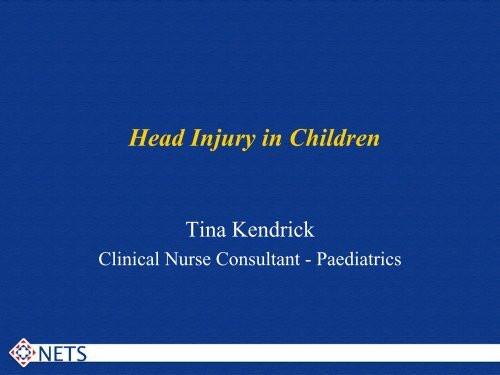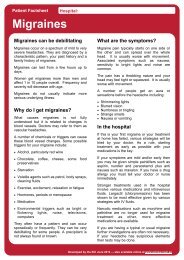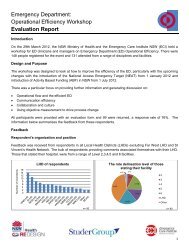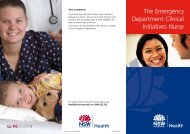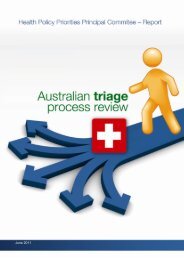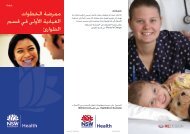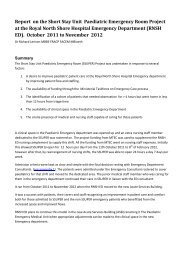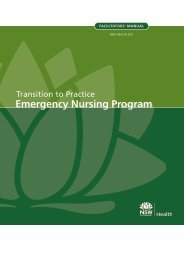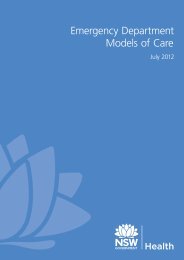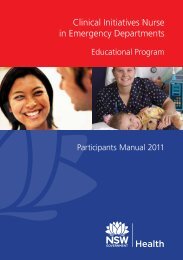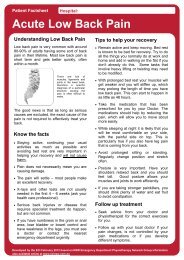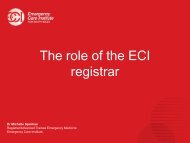Head injury in children - Emergency Care Institute
Head injury in children - Emergency Care Institute
Head injury in children - Emergency Care Institute
- No tags were found...
Create successful ePaper yourself
Turn your PDF publications into a flip-book with our unique Google optimized e-Paper software.
<strong>Head</strong> Injury <strong>in</strong> ChildrenT<strong>in</strong>a KendrickCl<strong>in</strong>ical Nurse Consultant - Paediatrics
Some Def<strong>in</strong>itionsNewborn< 28 daysInfant< 1 yearChild< 16 th birthday (DoH)
<strong>Head</strong> Injury• Lead<strong>in</strong>g cause of mortality & morbidity <strong>in</strong> <strong>children</strong>:– Road trauma, falls, bicycle accidents, abuse andviolence• There are no “magic bullets” that have significantlychanged outcome <strong>in</strong> the past decade• Outcome still l<strong>in</strong>ked to severity of <strong>in</strong>itial <strong>in</strong>sult
<strong>Head</strong> Injury• Children have <strong>in</strong>creased survival but <strong>in</strong>creasedmorbidity as diffuse bra<strong>in</strong> <strong><strong>in</strong>jury</strong> prevalent• Often associated with sp<strong>in</strong>al <strong><strong>in</strong>jury</strong> but lower<strong>in</strong>cidence <strong>in</strong> <strong>children</strong>• <strong>Care</strong> is focussed on:– Close observation– prevention & m<strong>in</strong>imisation of secondary <strong>in</strong>juries– rehabilitation
Secondary Bra<strong>in</strong> Injuryrefers to the cascade ofphysiological and biochemicalevents that occur after primary<strong><strong>in</strong>jury</strong> and worsen outcome
Most Frequently Occurr<strong>in</strong>g• Hypocapnia• Hypotension• Acidosis
Associated With WorseOutcome• Hypocapnia• Hypotension – occurred twice asoften <strong>in</strong> non-survivors• Acidosis• Hypoxia• Hyperglycaemia• Hypothermia* <strong>in</strong> younger<strong>in</strong>dividuals
Developmental Considerations• Unwitnessed/unobta<strong>in</strong>able history of lossof consciousness• No LOC, especially <strong>in</strong> < 2s does notpreclude <strong>in</strong>tracranial <strong><strong>in</strong>jury</strong>• GCS may not be reliable <strong>in</strong> young<strong>children</strong>; a modified scale should be usedfor <strong>in</strong>fants and young <strong>children</strong>• Parents generally provide most reliable &trustworthy <strong>in</strong>formation
Anatomic Differences• Characteristics of child skull:– Th<strong>in</strong>ner, provides less protection– Depressed skull # more prevalent– Pliability means underly<strong>in</strong>g bra<strong>in</strong> <strong><strong>in</strong>jury</strong> +/-bleed<strong>in</strong>g <strong>in</strong> the absence of fracture– <strong>Head</strong> = 18% of TBSA <strong>in</strong> <strong>in</strong>fants; 9% <strong>in</strong> adults– Intracranial and scalp haematomas cantherefore represent significant blood loss
Anatomic Differences• Blunt trauma can be followed rapidly byacute bra<strong>in</strong> swell<strong>in</strong>g• Can occur despite:– no significant history– No visible abnormality of the head• Children more disposed to develop<strong>in</strong>goedema – higher bra<strong>in</strong> H 2 O content• This requires close monitor<strong>in</strong>g of fluidbalance
Body Proportions
Inflicted Injury• Have a high <strong>in</strong>dex of suspicion where:– History is <strong>in</strong>consistent with physical f<strong>in</strong>d<strong>in</strong>gs– Infants present with serious head <strong><strong>in</strong>jury</strong> afterreportedly m<strong>in</strong>or fall– History changes over time– Another child is blamed– A delay <strong>in</strong> presentation to ED• Most common cause of head <strong><strong>in</strong>jury</strong> <strong>in</strong><strong>in</strong>fants
Assessment of Conscious LevelAVPU Assessment ToolA: Patient is Alert andAge-appropriateV: Patient responds to VoiceP: Patient responds toPa<strong>in</strong>ful stimuliU: Patient is Unresponsive
Five Assessment Parameters• Level of consciousness• Motor function• Respiratory patterns• Cranial nerve response• Vital signs
Vital Signs• Temperature• SpO 2• Pulse and ECG• Respirations• Blood pressure• Standard Paediatric Observation Charts(SPOC) should be used
Limitations of the Glasgow ComaScale for Children• Teasdale & Jennet did not report patientages <strong>in</strong> their orig<strong>in</strong>al work• Recognised early on (late 70’s) that theGCS was limited <strong>in</strong> assess<strong>in</strong>g <strong>children</strong>under 10 years of age• Preverbal <strong>children</strong> (under 2 years)particularly challeng<strong>in</strong>g
Eye Open<strong>in</strong>g Response• Spontaneously (4)• To speech (3)• To pa<strong>in</strong> (2)• None (1)
Eye Open<strong>in</strong>g Response• No age-related modification necessary• Best score is 4
Best Verbal Response
Best Verbal Response 4-15 years• Orientated and converses (5)• Disorientated and converses (4)• Inappropriate words (3)• Incomprehensible sounds (2)• None (1)
Best Motor Response < 4 years• Obeys verbal command or performs normalspontaneous movements (6)• Localises pa<strong>in</strong> or withdraws to touch (5)• Withdraws from pa<strong>in</strong> (4)• Abnormal flexion to pa<strong>in</strong> (3)• Abnormal extension to pa<strong>in</strong> (2)• No response to pa<strong>in</strong> (1)
Best Motor Response 4-15 years• Obeys verbal command (6)• Localises pa<strong>in</strong> (5)• Withdraws from pa<strong>in</strong> (4)• Abnormal flexion to pa<strong>in</strong> (3)• Abnormal extension to pa<strong>in</strong> (2)• No response to pa<strong>in</strong> (1)
Classification• Severity classification is traditionally used• Is GCS-based• Mild head <strong><strong>in</strong>jury</strong> (GCS 14 - 15)• Moderate head <strong><strong>in</strong>jury</strong> (GCS 9 - 13)• Severe head <strong><strong>in</strong>jury</strong> (GCS 3 - 8)
Severity• In <strong>children</strong>, CHALICE criteria is now be<strong>in</strong>gused for management• A more comprehensive system, us<strong>in</strong>g riskfactors (<strong>in</strong>clud<strong>in</strong>g GCS) to more accuratelydetect <strong>in</strong>tracranial <strong><strong>in</strong>jury</strong>• Places <strong>children</strong> <strong>in</strong>to Low, Intermediate orHigh risk groups, which determ<strong>in</strong>esmanagement
Low Risk• Consider immediate discharge
Intermediate Risk• Close observations for 4-6 hours post-<strong><strong>in</strong>jury</strong>until GCS is 15 for 2 hours• May go home if GCS 15, asymptomatic,responsible carers and normal CT• Any child not asymptomatic andneurologically normal at 6 hours needsdiscussion with paediatric expert orneurosurg
High Risk• These <strong>children</strong> require urgent imag<strong>in</strong>g,neurosurgical and Paed ICU consult viaNETS - regard<strong>in</strong>g transfer, CT decisions• CT abnormalities need Neurosurg <strong>in</strong>put• Those with normal CT should still beobserved for 6 hours m<strong>in</strong>, may requireadmission
Further Information• Children’s Hospitals websites Fact Sheets forparents• NSW <strong>Institute</strong> of Trauma and Injury• Cl<strong>in</strong>ical Excellence Commission’s “PaediatricBetween the Flags”• ACCCN’s Critical <strong>Care</strong> Nurs<strong>in</strong>g (2012)• DETECT Junior• Frank Shann – DRUG DOSES
References• Australian and New Zealand Paediatric Intensive<strong>Care</strong> Data Registry Report, 2010• Brady, Ca<strong>in</strong> & Johnston (2012) Justify<strong>in</strong>g referralsfor paediatric CT. MJA 197 (2) p95-98• Guidel<strong>in</strong>es for the Acute Medical Management ofSevere Traumatic Bra<strong>in</strong> Injury <strong>in</strong> Infants, Childrenand Adolescents 2 nd Edition January, 2012 PediatricCritical <strong>Care</strong> Medic<strong>in</strong>e
Useful References
Useful References


